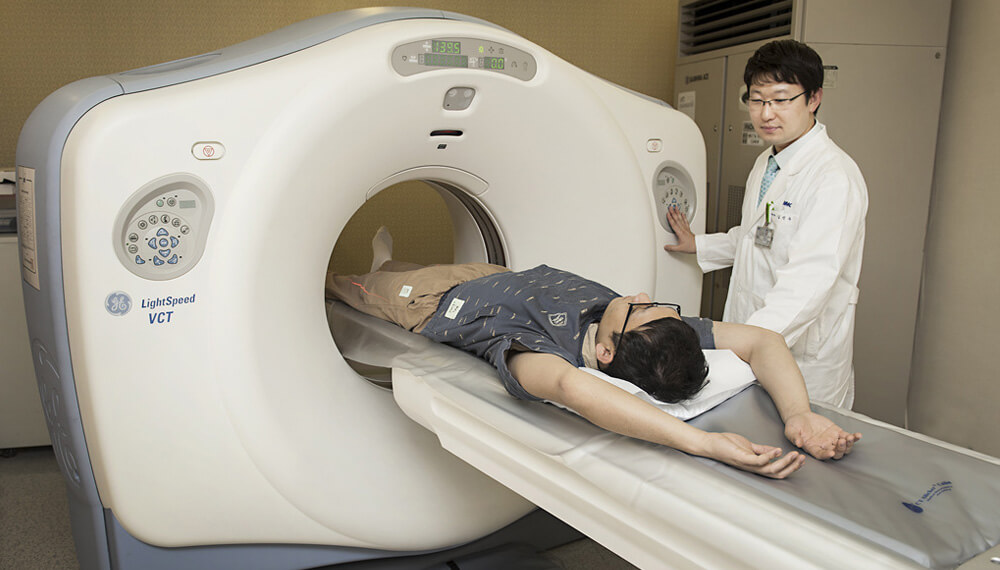New Technologies Improve
Survival Rates of Cancer Patients


Cancer was once regarded as terminal illness. Thanks to the development of new technologies, now there are higher chances of curing cancer compared to the past. For more serious cases, even though some cancer patients are considered incurable, their doctors still manage to control their conditions and improve their overall quality of lives, as well as prolonging their survival periods.
The research and development of new technologies covering on both areas like therapy and detections. Having assisted by such medical advancement, doctors can customise and personalise cancer treatment methods, thus improving patient’s chances of curing, and getting rid of previous practices of solely relying on standard therapies for achieving efficacy. Of course, the final outcome is still very much depending on patient’s current health condition and severity of illness.
In recent years, two new technologies have been widely used in cancer treatments, namely cancer biomarkers and interventional oncology. The former can measure substances produced by tumour cells and enable targeted cancer therapy; while the latter Is a kind of microsurgical treatment, which are performed mainly for those patients who are viewed not suitable for receiving other types of cancer therapies.
Cancer biomarkers
Personalised Cancer Therapies
The cancer biomarker is a new detection technology that helps cancer patients to find the tumour characteristics, so that doctors can personalise their therapies and avoid the side effects caused by unsuitable standard therapies. This new technology is very helpful for patients when seeking their suitable therapies.
Although not all tumours have their own biomarkers, after all, every person or every cancer has a different condition and pathology, but generally, non-small cell lung cancer, colon cancer, and even breast cancer are having their detectable biomarkers respectively.
Currently, lung cancer accounts for approximately 40% of all cancer cases in Malaysia, once its biomarkers are found, it allows doctor to identify more appropriate therapy and improve the effectiveness of cancer treatments. As for small cell lung cancer, because its biomarkers are not obvious, it is rather difficult to detect them during the test, thus small cell lung cancer will be treated by other types of treatments instead.
The test of cancer biomarkers is not considered new in Malaysia. It has been introduced for 4 to 5 years. Now many local laboratories can already perform such tests and do not need to send patients’ samples to foreign countries anymore. The tests usually are performed at the local hospitals, of which results can be obtained within 2 to 5 days.
However, this test should be carried out by reliable and reputable hospitals, because inaccurate results will cause improper cancer treatment, which ends up causing more harms in comparison to the use of standard cancer therapy.

Testing for personalise therapy
Biomarker detection tests can be performed locally, except for some other advanced tests, such as next generation sequencing (NGS), which must be sent to foreign countries, with higher costs, ranging from RM20,000 to RM25,000.
Clinical experiments have shown that, based on the treatments made by the biomarkers, patients generally respond to 50 to 60% of the therapy, and some patients even have 80% to 95% of response rates, which are strong indications of effective therapies.
Although some cancers are incurable, it is possible giving cancer patients targeted treatments and preventing their diseases from worsening. In addition, it also extends their survival period, and improves the quality of life. Patients do not have to bear the side effects nor receive any unsuitable therapies unnecessarily. Moreover, less money is wasted as well.
Through the biomarker test results, individualized therapies can be formulated for the patients. As such, patients can get their effective drugs straight away. When the patient is diagnosed with cancer, doctor will advise the patient to do a biomarker testing. However, if cancer is either a rare type or absence of any biomarker, then biomarker testing will not be recommended. Ultimately, the doctor’s experience and judgment are critical to make such decision.
At present, there is also another new testing method – liquid biopsy which extracts blood and investigate cancer genes. Relatively this test is less accurate compared to biomarker testing. However, some patients who are found not suitable for biomarker testing, so they can do liquid biopsy testing as an alternative.
Interventional Oncology
Interventional oncology is one of the treatment options for cancer patients. It is performed with minimally invasive surgery, and patients do not have to bear the risk of major surgery.
Interventional oncology is applied based on the stages of cancers. Different stages of cancer have different types of therapies. In the early stages of cancer, small needles are used for ablation treatment. During the mid-stage, when the tumour is larger, embolization, also known as arterial chemoembolization, is used to “poison and kill” tumours.
In the case of advanced stage cancer, although it cannot be cured, patients will also face various medical problems such as pulmonary edema (fluids in the lungs) and difficulty of breathing. Doctor will first use small needles or small catheters to drain the patient’s fluids and improve the condition. The rest of treatments can only be executed thereafter.
Many current cancer treatments do not require major surgery, since image-guided ablation of tumors, has gradually replaced surgery, especially for treating early-stage cancers.
For example, early stage of liver cancer is viewed suitable for using interventional oncology therapy. Even for some advanced-stage cases, since the cancer cells have been spread widely, therefore aggressive chemotherapy is no longer a viable option. Under such circumstance, doctor can still use interventional oncology therapy to treat the patients.
Judging from the current trend of cancer development, only 20% of first-time-diagnosed patients are found suitable for surgery, for example early stage of liver cancer patients. Thanks to early detection, liver function is still sufficient to cope with the operation after removal of the tumour, as such resection is deemed viable. Unfortunately, most of the cancer patients are diagnosed during middle or advanced stages, which explaining why only 20% of diagnosed patients are suitable for surgery.
Hepatitis B is a common hepatitis in Asia, and it is also one of the major causes of liver cancer. This process may take 20 to 30 years. Although Malaysia and New Zealand began compulsory national vaccination program of hepatitis B during the 1990s, hepatitis B are still threatening people aged over 40 years. Statistics indicated that currently many liver cancer patients are people aged 50 to 60 years old, so the risk of hepatitis B still exists in our country.
The vaccination program of hepatitis B, indeed helps to reduce the number of liver cancers. For example, Taiwan is implementing the vaccination plan earlier than ours. Therefore, the number of liver cancer cases in Taiwan has dropped. At present, liver cancer is still a common cancer in Asia, especially in China. Because there are too many people, not everyone has been vaccinated, hence the risk is even higher there.
We can predict that the number of hepatitis B cases in Malaysia and Singapore will decrease in the future, but it will be replaced by threat of fatty liver, as obesity in both countries will continue to rise.
Fatty liver cannot be taken for granted, since it is also identified as one of the risk factors causing liver cancer. Therefore, diet control is very important. Its medical risks are not merely related to diabetes and fatty liver complications, apparently liver cancer should part of the equation too.
Recurrence rate as low as 20%
It has been about 20 years since the introduction of interventional oncology therapy. It is a very low-key discipline. Relatively, it is a new technology in Asia, it was introduced to this region about 5 to 10 years ago. However, not everyone can accept this therapy.
Interventional oncology therapy differs with target therapy. The latter is based on oral and injectable drugs, while the former is image-guided, applying together with chemotherapy, hyperthermia, microwaves, and radiofrequency methods.
Metastatic kidney cancer and lung cancer patients are suitable for cold energy therapy. This therapy uses image-guided technology and inject minus 40-degree drugs into tumour and kill tumours with this extreme-low temperature. To those tumours that are detected near to other organs, doctors can also use this therapy and freeze the tumours till they die.
Any tumour has a chance of recurrence. The recurrence rate of tumour is about 10%-20%, after an interventional oncology therapy is performed. Because of its minimal invasive nature, this therapy can be performed many times, unlike conventional surgery.
Any therapy has side effects, interventional oncology therapy is no exception. It main side effects are mainly restricted to bleeding and inflammation, while fatal side effects are less than 1%. In general, minor bleeding is common, and self-recovery will occur after surgery.
Drug-eluting beads
Embolization Therapy of Liver Cancer
The treatment of liver cancer, including liver transplantation, tumour resection, and arterial embolization, has shown some good effects. In recent years, the invention of drug-eluting bead has been applied to the treatment of liver cancer, whereby it efficacy is found even better than arterial embolization.
Older cancer patients normally have weak organ performance and poor immunity. High-risk surgical resection treatment is usually not the best method of diagnosis and treatment as such. Yet, this does not mean that elderly patients are “untreated” entirely. Thanks to the advancement of medical technologies, minimum invasive procedures like small incisions and local anaesthesia, has put interventional oncology therapy become the first choice of treating many elderly and high-risk cancer patients.
Case Study
This patient had found that his left liver had tumours as early as 3 years ago and he had received treatment, but the effect was not satisfactory.
Today, the patient’s alpha-fetoprotein (AFP) value has reached as high as 2944 ng/mL. This indicates that his cancer has recurred, and the patient’s left liver tumour has become bigger, while his right liver also detected a small tumour.
The left liver tumor is 12 cm in size, the tumor has almost touched the abdomen, till this patient has already felt extreme discomfort. Should the tumor is blasted, he may lose his life. Under such circumstances, it is very difficult for the patient to undergo open surgery.
Even if he is treated with surgery, the doctor will not remove both left and right liver tumors at the same time. This treatment must be planned and executed in stages, starting by handling the giant tumors on the left side, thereafter focussing on right liver tumor.
Many people know that the best treatment for liver cancer is doing liver transplantation or tumour resection. However, in this case, the patient cannot be treated by surgery. Doctor can only cut off the nutrient supply of the tumour through the method of arterial embolization and deliver chemotherapy drugs into the tumour so that its cells die.
The 12-cm tumour can be regarded as very large tumour, and the blood vessels that connect the tumour are numerous, so it is difficult to use the traditional embolization therapy. Therefore, doctor chose to perform Transartherial Chemoembolization (TACE) with Drug-Eluting Beads.
TACE is the latest development in recent years. In addition to embolizing liver tumour blood vessels, it also allows cancer drugs to slowly release within the tumour to kill cancer cells.
Traditional chemotherapy has side effects
Traditional chemotherapy brings many side effects to the patient, including alopecia (hair loss), gastrointestinal discomfort, loss of white blood cells, etc., while TACE, drug-eluting beads are slowly released drugs, significantly reducing the side effects and complications of chemotherapy.
The treatment process of the patient was very smooth. Doctor successfully delivered drug-eluting beads into the tumour and blocked the tumour vessels. Doctor planned to control the left liver 12cm-tumor first, and then treat the right tumour one or two months later.
The entire course of treatment did not exceed 30 minutes. The patient only underwent local anaesthesia and did not feel any discomfort. Doctor believed this treatment can achieve the desired therapeutic effect.

Diversify Liver Cancer Treatments
In Asia, the occurrence of liver cancer is mainly caused by chronic hepatitis B, hepatitis C, and liver cirrhosis. It is known as the “trilogy of liver cancer.” Many people think that we should focus on the treatment of liver cancer. In fact, liver cancer can be prevented and avoided because hepatitis B can be protected by vaccination. Hepatitis C also has almost curable by using drugs. It is believed that after removing the two major causes, can greatly reduce the risk of future generations of liver cancer. However, health education is a long-term plan. We still need to treat many patients who are already suffering from liver cancer.
In a clinical trial comparing TACE with transcatheter arterial embolism (TAE), the three-year survival rates of the two treatments were 73.5% and 58.5%, respectively. In short, TACE has given better effects.
There are different stages of liver cancer, and the TACE has the best therapeutic effect in all stages of liver cancer. Of course, TACE is unlikely to replace liver transplants and tumour resections, but if drugs can be used to control tumours and “downstage” tumours that could not be removed to the stage of resectable cancer, then surgery and prognosis will be improved.
Usually, it takes a long time to wait for the liver transplant. If the liver cancer patient waits for liver transplantation, if the tumour is not treated, it will grow. Therefore, by using TACE treatment, patients will have more time waiting for liver transplantation. The success rate of TACE is as high as 75.6%, which is deemed as a highly effective treatment.
Clinical trials have shown that the survival rate of TACE treatment is 71.6% for 3 years. If liver transplantation can be performed later, the patient’s 3-year survival rate can reach 90% or more.
Apparently, the treatments of liver cancer are getting more diversified than the past now. Hence, the patients should get rid of the old concept and accept multiple treatments for achieving the best results.
Hepatic Arterial Embolization
One-third of alcohol mixed with two-thirds of lipiodol has the best curative effect, allowing alcohol to travel through the smallest blood vessels, through the hepatic artery to the hepatic portal vein, and attacking tumours both ways.
The transarterial alcohol embolization used to treat liver cancer is designed to use alcohol as a therapeutic drug. Alcohol has a strong damaging power on liver, therefore this therapy should be performed by experienced doctors to reduce the risk and improve the efficacy.
Alcohol is an ancient substance that is mainly used in medicine as a sclerosing agent to block blood vessels. Some congenital arteriovenous disorders cause rapid blood flow to the blood vessels. Usually, doctors use catheters to deliver alcohol through the artery to the disordered area. When alcohol comes in contact with a blood vessel, it can damage the blood vessel wall and cause blood vessel obstruction. Disturbance problems can be solved.
In addition to formation of liver tumours, there are many more blood vessels supplying nutrients to cancer cells, which enable tumours grows rapidly and metabolizes. By using treatment of arteriovenous disorder as a reference, there are doctors using transarterial alcohol embolization to block blood vessels of liver.
The efficacy of alcohol is strong. It can be said that no drug is stronger than it is. Some people used pure alcohol arterial embolization to treat liver cancer, but they are too powerful and need to be mixed with other substances.
Lipiodol can balance the alcohol concentration, and the two can be mixed with each other without decomposition and reduction.
Lipiodol is also a substance that can be visualized under X-ray radiography. Therefore, the alcohol mixture lipiodol is transported to the blood vessels. It can be clearly seen under imaging radiography. Another characteristic of lipiodol is its “stickiness”, which allows it to exert its effects on the adhesion of alcohol to the blood vessels.
The ratio of alcohol-alcoholic lipiodol is the key to liver cancer treatment. Excessively high levels of alcohol can cause the drug to be embolized in the early stages of delivery thus preventing alcohol from successfully entering the tumour and killing cancerous cells.
There are studies found that one-third of alcohol mixed with two-thirds of lipiodol formulations gives the best effect, it allows alcohol penetrating into the smallest blood vessels, through the hepatic artery to the hepatic portal vein, and attack tumours from both ways.
The use of hepatic arterial embolization is suitable for tumours less than 12 cm, and some tumours have a permanent effect despite they are being treated one-off. However, not all patients with liver tumours are able to accept this treatment. Some patients with poor liver function, debilitating body function, diffuse liver cancer, and large tumours are more likely facing higher risks than gaining benefits. Therefore, it is not recommended to use transarterial alcohol embolization therapy for this group of patients.
The efficacy of transarterial alcohol embolization for the treatment of liver cancer is more significant than that of traditional chemotherapy. Clinical trials have shown that the efficacy of the two groups in eradicating tumours is 70% and 50% respectively; in the 6 months after treatment, the two groups, noted the patients achieved a complete response of 60% and 37.8%, respectively; the relapse periods after treatment of the two groups, were found 14.8 months and 9.3 months, respectively.
Disease screening
Reduce morbidity and extend life expectancy!
Screening for diseases is an effective measure. Physical examination is performed despite the absence of signs of disease, will help in making early diagnosis, executing treatment, and preventing diseases from happening altogether.

The Best Way To Extend Your Life
Different ages and genders have different test items. If an abnormal reaction is found after the test, the involved parties must conduct more frequent inspections and observations. Unfortunately, many diseases are diagnosed only at advanced stages, which causes difficulties in treatment.
On the other hand, thanks to higher awareness on personal health, more and more diseases are detected early in life, many cases found out during blood tests. Once further tests and final diagnosis are done. The Multi-Disciplinary Team (MDT) will intervene. They will give advice and recommendations on treatments. Of course, the final decision is still on the hands of patients.
In the prevention of liver cancer, at least 50% of hepatocellular carcinoma (HCC) or liver cancer is detected at an early stage through screening. The latter means that those tumours are less than 3 cm and less than three tumours in total. Early detection and treatment is best way to prolong the survival periods of patient.
According to records, the average 5-year survival rate after treatment of liver cell cancer patients in Korea 20 years ago was 11%. Although the overall prognosis of this cancer is still poor, the average survival rate after hepatectomy 20 years later, is found more than 30% today. Indeed, this is a very important breakthrough in medicine.





